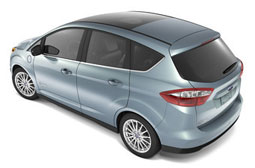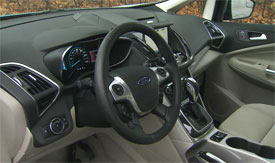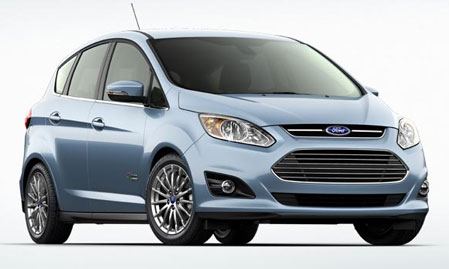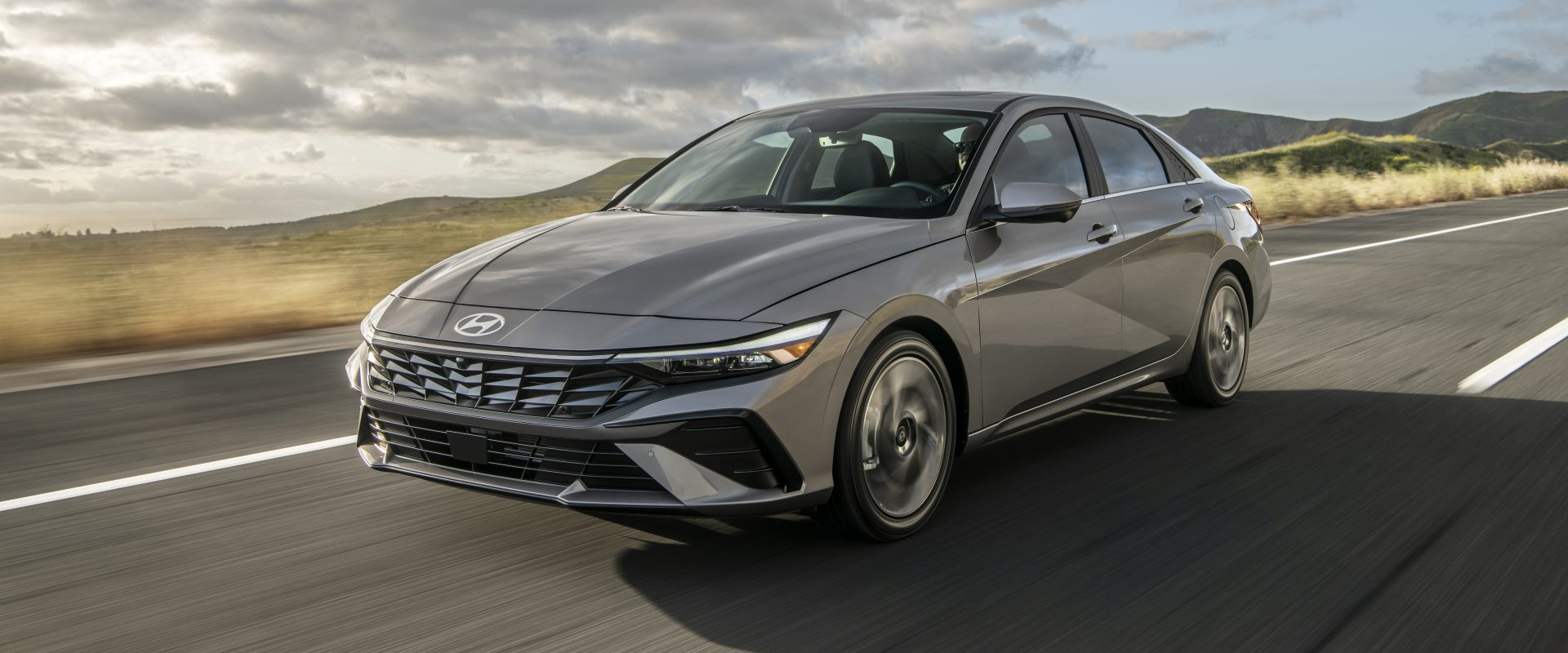2013 Ford C-Max Energi
We approached our first extended stay with a 2013 Ford C-Max Energi with both immediate interest and long term anticipation. The C-Max Energi is of course based on the C-Max wagon that is sold throughout the world in a number of varieties, but in hybrid form only here in the states. The Energi differs little from the hybrid version, but big things often happen because of little changes.
The primary one, naturally, is that the Energi functions as a fully electric vehicle until you exhaust the high voltage battery, and then it starts exhausting gases from its I4 engine and operating as a full-hybrid, just like the regular C-Max. In order for this to happen there are a few hardware changes, of course; the major one being a larger 7.6kWh lithium-ion battery. And it also gets a larger fuel tank, additional cooling, and changes to the exhaust.
All that adds weight so not surprisingly Government Fuel Economy Ratings are about 9% lower than the C-Max Hybrid at 44-City, 41-Highway, and 43-combined. Those ratings are also 14% less than its sole rival the Prius Plug-In Hybrid.
But, add in a miles-per-gallon equivalent of 100-combined for EV time, and you get a much better Energy Impact Score of just 4.2-barrels of yearly oil use and CO2 emissions of only 1.8-tons. What does all of that mean for you and me?
 Well, after a 170-mile weekend of the usual errand running including karate classes and baseball practices, one of our staffers netted a great average of 64.5 miles-per-gallon of Regular. Obviously the more time you can spend in EV-mode, the better off you’ll be.
Well, after a 170-mile weekend of the usual errand running including karate classes and baseball practices, one of our staffers netted a great average of 64.5 miles-per-gallon of Regular. Obviously the more time you can spend in EV-mode, the better off you’ll be.
On that, Ford claims an EV range of 21-miles. We didn’t get that many at any one time, mostly due to the very cold weather during our testing, but we did see consistent runs of 15-17 miles. Charge time is 2½-hours on a Level 2, 240-volt charger; up to 7-hours plugged into a standard household outlet.
Compared to the Hybrid, the Energi’s range increases from 570 to 620 miles, while top speed decreases from 115 to 102 miles-per-hour. EV-only speed tops out at 85. The basic front drive powertrain remains the same; a 141-horsepower, 2.0-liter, Atkinson-cycle, I4 mated to an 88kW electric motor, all coupled to a continuously variable transmission.
Compared to the Prius Plug-In, the C-Max has a longer range, and thus a higher MPGe rating. But it also has another advantage; it’s a lot more pleasant to drive, all with a very quiet and solid ride. Still, if you get too aggressive, the C-Max’s tall shape starts to feel a little top heavy.
As for acceleration, the Energi is a clear winner here as well, dashing to 60 in 8.5-seconds, more than 2-seconds faster than a Prius Plug-In. The quarter mile is also faster at 16.7-seconds and 87 miles-per-hour.
 The Energi’s stylish and nicely finished interior gets the nod too, and comes in SEL trim only; which means SYNC with navigation, push-button start and Active Park Assist are all standard. A back-up camera is optional as is Ford’s hand’s free power lift-gate. Storage space does take a hit due to the larger battery mounted in the rear cargo area. Space behind the rear seats falls from 24.5 cubic-ft. to a 19.2, or a bit less than the Prius.
The Energi’s stylish and nicely finished interior gets the nod too, and comes in SEL trim only; which means SYNC with navigation, push-button start and Active Park Assist are all standard. A back-up camera is optional as is Ford’s hand’s free power lift-gate. Storage space does take a hit due to the larger battery mounted in the rear cargo area. Space behind the rear seats falls from 24.5 cubic-ft. to a 19.2, or a bit less than the Prius.
Whether in EV-mode or operating as a full-hybrid, the Energi feels plenty peppy for both city commuting and highway merging, and adequately equipped for both missions. And now it comes down to deciding whether the Energi is a good value, or just a good idea. Well, pricing starts at $33,745. That’s $4,585 over an SEL equipped C-Max Hybrid, and just a bit more than a base Prius plug-in.
So, is it worth it? Certainly, if your commute is under 20-miles and you can function mostly on EV-power alone; but if most of your trips are of the long variety, you’re much better off sticking with the regular C-Max Hybrid.
We applaud Ford for being bold enough to mount a direct challenge to Toyota’s Prius juggernaut, and for giving buyers true options, whether it’s a full EV, Hybrid, or something in between like the 2013 Ford C-Max Energi. That’s one “energy” plan we can all get behind.
Specifications
- Engine: 2.0-liter
- Horsepower: 141
- Torque: 129 lb-ft.
- 0-60 mph: 8.5 seconds
- 1/4 mile: 16.7 seconds @ 87 mph
- EPA: 44 city/ 41 highway
- Energy Impact: 4.2 barrels of oil/yr
- CO2 Emissions: 1.8 tons/yr
2024 Hyundai Elantra
Basic Transportation At Its Best…And That Is A Compliment
For those of you who write in every week bemoaning the fact that all we seem to do around here is test incredibly expensive cars and EVs that only the very well to do can afford, this one’s for you. It’s a commuter and budget friendly mainstay from Hyundai, the compact Elantra sedan. And, it has been nicely updated for 2024.
We clearly do enjoy driving high-performance machines and ultra-luxury rides around here, but like most of you, when it comes time to drive home at the end of a long workday, we do so in something much more practical and affordable, like this 2024 Hyundai Elantra sedan.
If you’re thinking the front end has gotten more aggressive, you’re right. Hyundai calls it a “Shark Nose” theme, and we’re guessing they were thinking more Great White than Hammerhead, though Megamouth shark would also apply. It helps for a low and wide look; more substantial than the typical compact. Other additions for ’24 include slimmer daytime running lights, revised stainless steel Hyundai emblem, reshaped front fenders, sport sedan-style rear diffuser with silver trim; a parametric pattern added to the C-Pillar, and new LED taillights that take up a lot more space on the highly sculpted decklid. Plus, new wheel designs in sizes ranging from 15- to 18-inches.
Standard engine in SE, SEL, and Limited grades is this naturally aspirated 2.0-liter I4 with 147 horsepower and 132 lb-ft of torque. Even with no hybrid assistance, it gets substantial Government Fuel Economy Ratings of 31 City, 40 Highway, and 34 Combined; we averaged a great 38.6 mpg of Regular.
Those high fuel economy numbers mean acceleration times are pretty high as well. It was in no particular hurry to get off the line at our test track, as after a slight jolt of power, it felt pretty sluggish going down the track, taking us a lengthy 9.4 seconds to hit 60 mph. Hyundai’s Intelligent Variable Transmission has some realistic simulated gear shifts built in, and they not only provided the feel of a true automatic, but kept engine noise from becoming overbearing. And while this 2.0-liter may not be a house-on-fire off the line, it has no problem keeping up with traffic, and feels like just the perfect amount of power for a practical and safe commuter car.
There are other engine options too. Two choices if you want to go faster, a 1.6-liter turbo with 201 horsepower in the Elantra N Line, and a 276-horsepower turbocharged 2.0-liter for the Elantra N; plus, one with even better fuel economy, a 1.6-liter hybrid with a 139 horsepower total output.
And despite some significant understeer, there was good feel through the cones of our handling course, both in steering and chassis feedback. We wouldn’t quite call it “point and shoot,” but it responded to inputs fairly quickly, with only moderate body roll. All-in-all, when it comes to performance, it doesn’t claim to bring a whole lot to the table, but does clearly overachieve with what it does bring.
And Hyundai is always overachieving when it comes to packing in features, yet has found a way of keeping things refreshingly simple with a good mix of touchscreen and manual controls. Lots of space too, both up front in the surprisingly wide front buckets, and in the rear bench with ample room for three. Updates for all Elantra interiors include softer materials on the door panels, upgraded instrumentation and additional charging ports, plus a surround view monitor and new H-Tex simulated leather for Limited trim.
Elantra pricing starts with an SE at $22,775, the SEL comes in at $24,725, Limited begins at $28,215, and the sporty N Line starts at $29,615. If you’re interested in the hybrid, base Blue starts at $27,400 with Limited at $30,600.
Some might say there’s not a whole lot that’s earth shaking about the 2024 Hyundai Elantra, but that’s mostly why we like it so much. When it comes to just delivering good, basic transportation with a high dose of unexpected amenities, Hyundai delivers once again.
Specifications
- Engine: 2.0-liter I4
- Horsepower: 147
- 0-60 mph: 9.4 seconds
- 60-0 Braking: 111 ft (avg)
- MW Fuel Economy: 38.6 MPG (Regular)
- Transmission: IVT
- Torque: 132 lb-ft
- 1/4 Mile: N/A (Track Maintenance)
- EPA: 31 City / 40 Highway / 34 Combined







